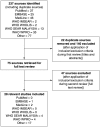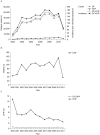Epidemiology of dengue disease in Malaysia (2000-2012): a systematic literature review
- PMID: 25375211
- PMCID: PMC4222702
- DOI: 10.1371/journal.pntd.0003159
Epidemiology of dengue disease in Malaysia (2000-2012): a systematic literature review
Abstract
A literature survey and analysis was conducted to describe the epidemiology of dengue disease in Malaysia between 2000 and 2012. Published literature was searched for epidemiological studies of dengue disease, using specific search strategies for each electronic database; 237 relevant data sources were identified, 28 of which fulfilled the inclusion criteria. The epidemiology of dengue disease in Malaysia was characterized by a non-linear increase in the number of reported cases from 7,103 in 2000 to 46,171 in 2010, and a shift in the age range predominance from children toward adults. The overall increase in dengue disease was accompanied by a rise in the number, but not the proportion, of severe cases. The dominant circulating dengue virus serotypes changed continually over the decade and differed between states. Several gaps in epidemiological knowledge were identified; in particular, studies of regional differences, age-stratified seroprevalence, and hospital admissions.
Protocol registration: PROSPERO #CRD42012002293.
Conflict of interest statement
JB, EI and ML are employees of Sanofi Pasteur. AHMZ has no conflicts of interest to declare. This does not alter our adherence to all PLOS policies on sharing data and materials.
Figures




References
-
- World Health Organization: Western Pacific Region (2012) Dengue: dengue in the Western Pacific region. Available: http://www.wpro.who.int/emerging_diseases/Dengue/en/index.html. Accessed 18 October 2013.
-
- Yusoff HM. (2008) National Dengue Programme in Malaysia. In: Asia-Pacific Dengue Program Managers Meeting,; 5–8 May 2008; Singapore. World Health Organization - Western Pacific Region. pp. 83–86.
-
- Skae FM (1902) Dengue fever in Penang. Br Med J 2: 1581–1582 Available: http://www.ncbi.nlm.nih.gov/pmc/articles/PMC2402112/. Accessed 18 October 2013. - PMC - PubMed
-
- Wallace HG, Lim TW, Rudnick A, Knudsen AB, Cheong WH, et al. (1980) Dengue hemorrhagic fever in Malaysia: the 1973 epidemic. Southeast Asian J Trop Med Public Health 11: 1–13. - PubMed
Publication types
MeSH terms
LinkOut - more resources
Full Text Sources
Other Literature Sources
Medical

